On test: Fendt broadens Cargo range with T740 telehandler
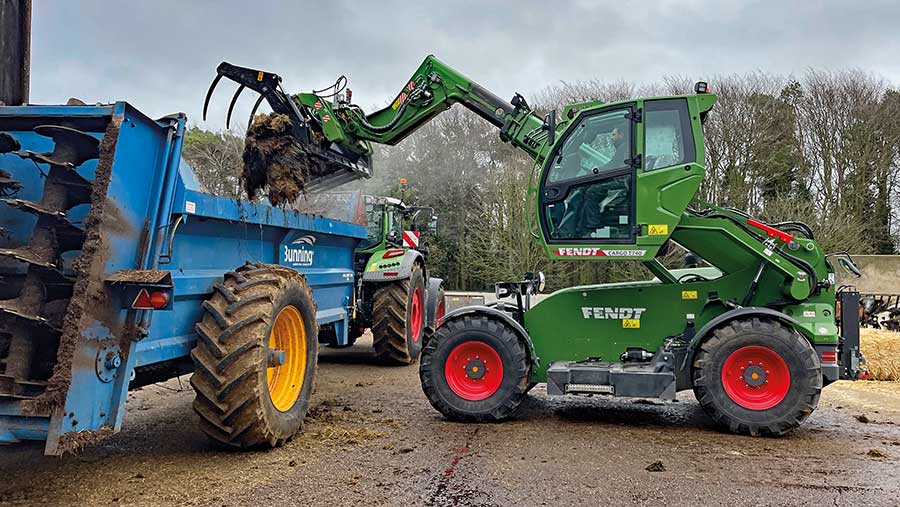 © James Andrews
© James Andrews The world is littered with gizmos that no one ever asked for, yet somehow became integral to our lives.
Lightbulbs, vaccines, airplanes and personal computers were all dismissed before they became indispensable and, in farming, it took years for inventions such as GPS guidance to become widely accepted.
So how will we look back on Fendt’s peculiar lifting-cab telehandler in a decade or so? It’s already been three years since the firm introduced the first of these novel machines, which are built by fellow German manufacturer Sennebogen.
See also: Ultimate guide to buying a telehandler 2023
But with a 5.5t lift capacity and 8.5m boom, the hulking Cargo T955 was too big for most farming enterprises, meaning just a handful found homes in specialist roles such as dockside grain handling.
Now there is a smaller model in the offing, which the maker hopes will see a significant uptick in sales.
Featuring a 7.7m boom and 4t maximum lift capacity, the Cargo T740 should be a far more useful size for medium to large farms and contracting businesses.
Plus, with the cab lowered, proportions are similar to rival machines from the likes of JCB and Manitou – overall height is a shade under 2.5m, it measures about 5.5m nose to tail and sits at roughly 2.5m wide.
Cab-lifting antics
We’ll continue with the nuts and bolts later, as the lifting cab is the major talking point on this machine.
Some will argue it’s pointless, others will say that there is just more to go wrong, but there is no doubt that it makes it stand out from the crowd.
In the short time we were in the seat, it was easy to see the benefits – once we’d got used to the bizarre sensation of floating 4m above the ground.
The main appeal is for those needing to load into tall trailers, as it allows the operator to get a clear view, avoiding the risk of tipping material over the far side or clobbering any supports for roll-over sheets.
But it’s not all about lifting it to full height. Raising the cab just a few inches off the deck activates the nitrogen accumulator suspension system, giving operators a pillowy ride over bumpy terrain.
This small amount of extra height also delivers better visibility of the machine’s extremities.
Cab position can be adjusted manually by pressing a foot on the floor-mounted raise and lower buttons, and there is the option of recording a pre-set height that it will automatically return to.
This is handy when loading grain out of a bulk store into a lorry, as it takes just one click of the joystick-mounted button to get you from ground level to trailer-lip height as you’re traversing across the yard.
It would be handy to have a second setting for the lower position, though.
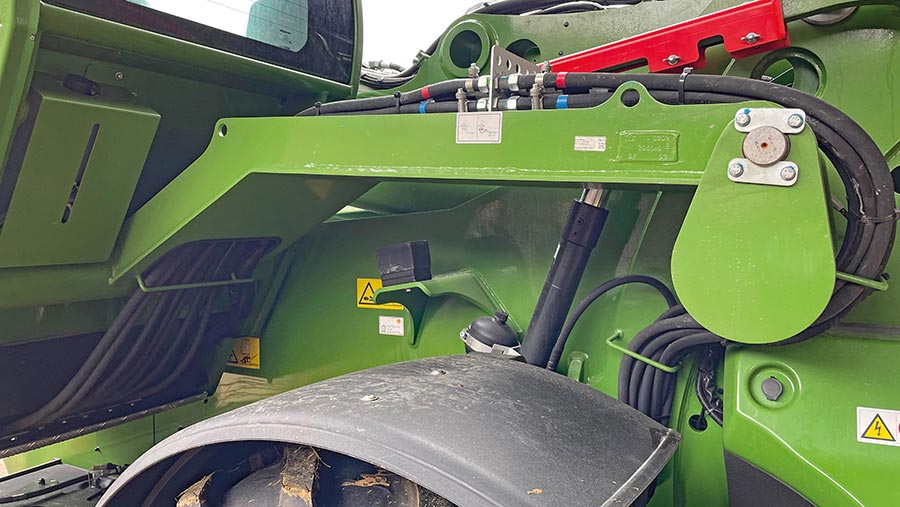
Raising the cab slightly engages the nitrogen accumulator suspension system © James Andrews
Operating at full height
All but the most gung-ho of pilots will exercise some caution when first driving around with the cab set to full height.
The wheel track looks awfully narrow from up there and it feels like the shallowest of potholes would have you toppling onto your side.
But because the machine weighs a hefty 9.4t, and most of the bulk sits low in the chassis, we’re assured it is possible to cruise around at normal speeds.
Operating the boom from this lofty perspective is also a learning curve and, for peak discombobulation, try moving the cab and boom at the same time.
Like the train next to you in a station pulling away, it’s not always easy to work out which one of you is in motion.
Amazingly, it is possible to open the door when the cab is at full height, although there is a warning buzzer to wake you up before you forget where you are and attempt to causally step out.
The top half of the cab door can also be left open when at full height, providing a sort of seated scissor lift; handy for clearing out the gutte
Cab interior and controls
Although the T740 is essentially a repainted Sennebogen machine, Fendt has made a couple of modifications to bring it a little more “on brand”.
In the cab, these include an upgraded seat and some minor changes to the controls. It’s a nice enough place to be, but it’s a far cry from the maker’s other product offerings.
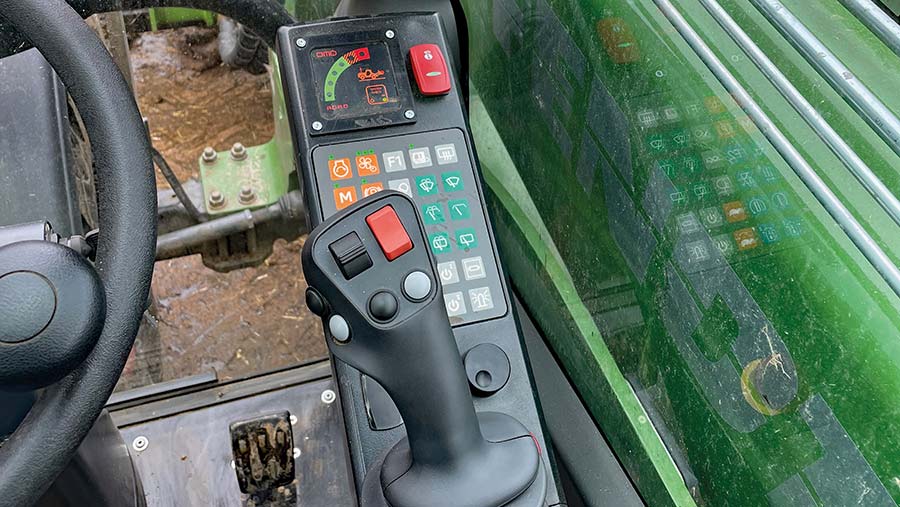
Fendt has made minor tweaks to the Sennebogen controls and fitted an upgraded seat © James Andrews
Not that lots of fancy kit is really necessary in a telehandler.
The important bit, the joystick, is comfortable to use, has an unobtrusive palm safety switch and puts all the main functions within easy reach.
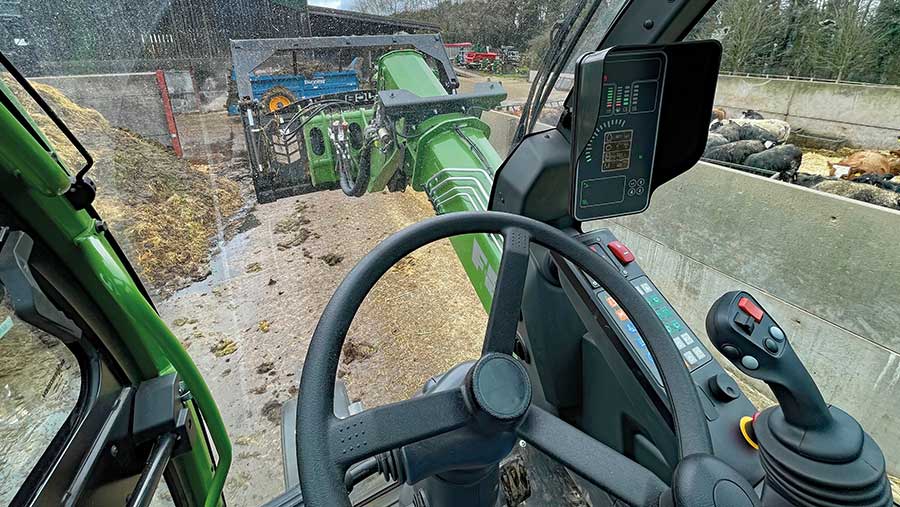
Room with a view – the cockpit lifts to 4.1m from the ground © James Andrews
Beefy boom
Sennebogen’s background in commercial handling means the Cargo T740 is built tough.
The boom is constructed out of 8mm and 10mm steel plate and has an octagonal profile to give it extra strength and keep it centred.
It also features a Z-bar linkage that gives it a breakaway force of 65kN, which is up there with some loading shovels.

© James Andrews
This has the added benefit of preventing forward movement of attachments, allowing a bucket to be crowed back when pushed tight to a wall, for example.
There’s also the choice of three operating modes, with the “Bucket” setting giving peak power for shifting heavy loads, “Pallet” reducing the performance for more precise positioning and “Road” disabling the hydraulics and engaging front-wheel steering.
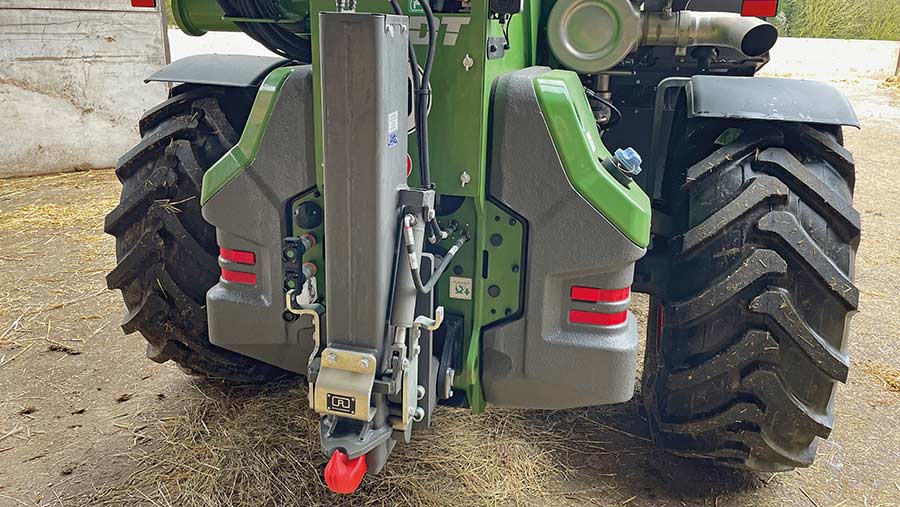
Rockinger pick-up hitch is optional © James Andrews
For added stability, it’s possible to spec a locking ram for the rear axle that prevents it articulating from side to side.
This can be set to engage automatically whenever the handler is at a standstill.
Buyers have the option of several headstocks, but our test model was fitted with Fendt’s take on a JCB Q-fit.
Finally, to keep maintenance chores to a minimum, an automatic greasing system is available, too.
Engine and running gear
Propulsion is provided by a four-cylinder, 138hp Cummins engine that drives a single-range hydrostatic transmission – available with 20kph, 30kph or 40kph top speeds – and a 170-litre/min hydraulic pump.
The choice of transmission won’t be to everyone’s liking, but hydrostatic drive is well suited to yard work, which is this machine’s forte.
Though there is the option of adding a Rockinger pick-up hitch, which is a handy addition for shunting trailers between buildings, it isn’t designed for pulling anything too weighty.
Also on the extras list is a cyclone air pre-separator for the engine and an automatic reversing fan.

© James Andrews
Verdict
Like all the big brands, Fendt has been on a mission to offer a full line of agricultural equipment so that its regular customers can get everything they need in-house.
Telehandlers were one of the last pieces of the puzzle.
But with brands such as Liebherr and Kramer already allied to Claas and John Deere, and Bobcat building machines for sister Agco brand Massey Ferguson, there weren’t many quality marques left to partner with.
Sennebogen was an untapped resource and with its tough commercial-grade machines, which are built in Germany, it clearly seemed worth a punt.
At the moment, Fendt has done little other than bolt on a few ag-spec parts and repaint Sennebogen’s two telehandler models in its own livery.
As these were designed specifically for recycling companies, sawmills and industrial sites, there are some compromises when using them for agricultural tasks.
It’s fair to say the Cargo T740 is a much handier size than the T955, but it’s still a machine best suited to operating in large yards.
The lifting cab is a unique party piece and is genuinely useful for loading into tall trailers, but it’s hard to see them becoming a regular sight on farms.
So, if Fendt wants to start selling telehandlers in big numbers, the Sennebogen partnership is probably going to have to yield some more ag-specific models
Fendt Cargo T740 specs
- Max lift capacity 4t
- Max lift height 7.7m
- Breakout force 65kN
- Max cab lift height 4.1m
- Engine 3.8-litre Cummins four-cylinder
- Transmission Single-speed hydrostatic
- Top speed 20/30/40kph options
- Approximate on-farm price £130,000

